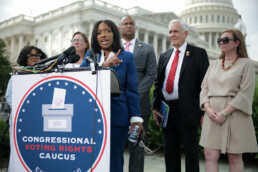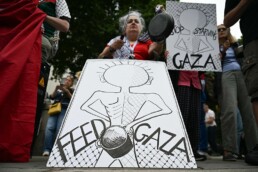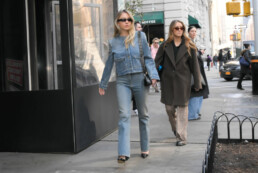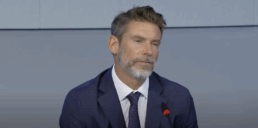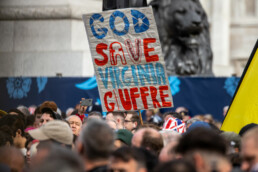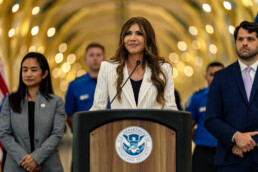A "Devastating" Blow to Breast Cancer Research
 August 7, 2025 Another green dildo was thrown onto a WNBA court last night, this time hitting two spectators and the Fever’s Sophie Cunningham. It’s the third dildoing in less than a month, and frankly, it’s the dumbest. We’ve all seen Cunningham yoke a girl for less, and some young punk really thought she was the one to try? In today’s newsletter, we take a look at RFK Jr’s latest chicanery. Plus, we take a quick trip to Love Island with Julianne Escobedo Shepherd to learn about colorism. We’ve also got your weekend reading list. Staying on Sophie’s good side, Shannon Melero  A “tremendous” setback: This week, known vaccine hater Robert F. Kennedy Jr. announced that the government would be canceling roughly $500 million in contracts committed to the development of mRNA technology—the research responsible for making viable COVID vaccines and saving millions of lives. Scientists have long been studying other applications for mRNA technology, looking to develop better flu vaccines and studying the possibility of putting mRNA to work in treating melanoma, lung, and pancreatic cancers. With some early success in those areas, hope was starting to bloom that mRNA technology could potentially improve women’s health in particular, via new ways to treat and even prevent breast cancer—but when it comes to medical research, hope dies without dollars. “The attacks on vaccine research are devastating to the future of breast cancer research,” Fran Visco tells The Meteor. Visco is the president of the National Breast Cancer Coalition and a 30-year breast cancer survivor. “We're just beginning to look at vaccines as possible treatment and prevention for breast cancer, and having the head of the Department of Health and Human Services say that mRNA vaccines have safety issues and pulling vaccine research funding…is going to set back breast cancer research tremendously,” she says. Essentially, the federal government has removed a tool in the fight against breast cancer before researchers have really even had the time to learn if it’s useful or not. Such a short-sighted move, Visco believes, means scientists won’t have the means to investigate what mRNA is fully capable of, because the government is the largest supporter of biomedical research in the country. There’s also a concern that the public may become more skeptical of vaccine research as a whole. “You need the public to believe in [the safety of mRNA technology] because they're going to have to enroll in the clinical trials in order to test whether these vaccines are effective or not,” Visco explains. “If the public is getting the message that the federal government doesn't believe in it, they will not want to be engaged in that type of research…so it hurts you at every level, and there's absolutely no basis for what the federal government is doing right now in terms of vaccines.” A number of medical researchers have called these funding cuts dangerous and argue that the decision flies in the face of decades of established scientific research. Visco echoes their concerns and cuts straight to the point: “People are going to die because of the positions that this administration has taken in health and research.” AND:
 The Call is Coming From Inside the VillaLove Island: USA has Latine viewers confronting their anti-Black historyBY JULIANNE ESCOBEDO SHEPHERD  MEMBERS OF THE SEASON 6 CAST AT AN EVENT IN NEW YORK (VIA GETTY IMAGES) Love Island is the escapist watch of the summer with its outsized personalities and tropical setting—but as the aftermath of this season has proven, it’s never truly an escape from the dynamics of the real world. A little background if you’re not one of the tens (hundreds?) of millions that made this season Peacock’s biggest streaming series ever: Love Island is a reality show in which a dozen “sexy singles” are sequestered inside a neon villa with the sole directive to find love amongst themselves, has been airing for a decade in the UK, and six years in the U.S., but it didn’t really take off here until last year, thanks to improved production values after a switch from CBS to Peacock. This summer, it was an inescapable hit: Love Island seemed like the only thing unifying the country, to be honest, a fact I chalked up to our desperate collective need for an hour of reprieve from encroaching fascism. And since it airs almost every single day for two months, it’s easy to immerse oneself in the petty dramas and flirtations of its sculpted and spray-tanned twenty-something cast. I’ve been watching Love Island for years—last summer I realized I had seen over 550 episodes, at which point I had to stop counting—and like the best reality shows, it manages to put larger-world concerns under a microscope; its anthropological utility is vast. Even in its unreal Fijian (or Mallorcan) setting, familiar biases and prejudices play out in real time. And this year especially, anti-Black racism has shown up both in the villa and among the show’s fanbase. This year was notable for the way Olandria Carthen and Chelley Bissainthe, this season’s beloved Black women leads, were characterized by fans and certain tabloid media. They were both perfectly dignified and two of the main reasons the season was watchable—only to find that, having emerged from the villa at the end of the season, they’d been saddled with the “angry Black women” stereotype. (Production has also been accused of airing decontextualized outbursts by Huda Mustafa, Love Island’s first-ever Palestinian cast member and an outspoken mother, while editing out the male behavior that led to her outbursts.)  WEEKEND READING 📚On resisting fascism: Meteor collective member Sarah Sophie Flicker tells the history of the Danish resistance—including her own great-grandfather’s role in it—and reminds us that we too can say no to tyrants. (The Nation) On ridesharing: “Uber received a report of sexual assault or sexual misconduct in the United States almost every eight minutes on average between 2017 and 2022.” The worst sentence you’ve ever read. (The New York Times) On your face: Wedding cakes are meant to be eaten, not shoved up the bride’s nostrils. Don’t marry these men! (The Cut)  FOLLOW THE METEOR Thank you for reading The Meteor! Got this from a friend?
|
![]()
The gerrys? They’re mandering.
 August 5, 2025 Greetings, Meteor readers, I am four weeks into toddler soccer camp, and let me tell you something: The transformation from normie to insufferable soccer mom was swift for me. I don’t think I can ever turn back. I wonder if this is what Deloris Jordan felt like. In today’s newsletter, we are mandering our gerrys and focusing on what we, the people, can control. Plus, a little good news for Unrivaled fans and players. Sports momager, Shannon Melero  WHAT'S GOING ONUnblurred lines: Last week, Rep. Jasmine Crockett (D-TX) sat in front of the Texas House of Representatives and read them for absolute filth during a committee meeting on congressional redistricting. In an impassioned speech, Crockett broke down exactly how Texas Republicans are “playing ‘move minorities around’ ” in their latest gerrymandering scheme. If successful, the map the Texas state legislature is proposing would create at least two new districts that would be, in Crockett’s words, “Anglo-majority”—meaning the likely election of two new Republicans, granting the GOP a vicegrip on the U.S. House in next year’s midterms. District maps—the ones that determine who your representative in Congress will be—are meant to be redrawn every ten years, using data from the most recent census to create districts that reflect the population. But what is unique about the Texas situation is that it is happening ahead of schedule. The GOP is trying to consolidate power ahead of the midterms, and as just about everyone has pointed out, the party is very clearly drawing lines to dilute the power of Black and brown voters. (That is illegal by the way.) You might think that they’re making such a bold attempt specifically because Trump said they were “entitled” to do—which he did—but the reality is that they’re also doing this because it’s worked devastatingly well in the past. “You can draw a district that almost guarantees one party is going to win instead of another,” former president Barack Obama explained in 2020. His own election, back in 2008, so alarmed right-wing Republicans that they invested significant energy and cash into redrawing districts to favor conservative voters. “You have voter histories and you have a sense of where people are typically going to vote…That could mean a decade of fairly drawn districts where folks have an equal voice in their government or it could mean a decade of unfair partisan gerrymandering.” Guess which timeline we’re currently living in? Gerrymandering is not exclusive to the Republican party, but historically, it has wielded that tool more effectively than Democrats. As The Meteor’s Cindi Leive pointed out two years ago, “The political machinery the right put in place [beginning in 2010] laid the groundwork for our current abortion hellscape. Many of the trigger bans that snapped into cruel effect after Dobbs were in states like Ohio, Missouri, and Georgia, where the majority of people favor legal abortion, but ruthless gerrymandering or voter suppression meant it just didn’t matter.” This game runs deep, and it touches every aspect of our lives. It’s also part of the reason why the average voter feels powerless and like little more than a pawn on a board whose squares are constantly shifting. So what can we do? Apply some pressure. 5calls has a script for calling your representative about Texas’s redistricting. You can join the effort to fight fire with fire via the National Democratic Redistricting Committee. Or you can be part of the movement to make maps fair through Indivisible. So let’s get to work. AND:

 BLESS THIS MAN. (VIA GETTY IMAGES)  FOLLOW THE METEOR Thank you for reading The Meteor! Got this from a friend?
|
![]()
Too Many Warnings Were Ignored
 July 31, 2025 Hi, sweet Meteor readers, You may recall our pregnancy-themed newsletter last week, which came about because I, your humble editor Nona Willis Aronowitz, am one million months pregnant with my second kid. (As someone who completely avoided summer the first time around, I can tell you that gestating in a heatwave is a whole nother level.) Anyway, today’s my last day at The Meteor ‘til December! Kindly send me some magical baby dust that blesses me with a chill newborn. Next week, you’ll be in the safe hands of author and former culture director at Glamour Mattie Kahn. Please welcome her with all the enthusiasm I currently have for watermelon ice pops. Today, we assess the myriad warnings–all in plain sight–that got us to this horrific place in Gaza. Plus, some evil trickery in Texas, and your weekend reading. Nona Willis Aronowitz  WHAT'S GOING ONThe long, visible road to starvation: Over the past two weeks, the headlines have been full of the devastating news about starvation in Gaza, with experts warning that famine is reaching “a tipping point,” and photos and stories documenting the severity of malnutrition in children. As a result, lawmakers and everyday people who hadn’t said much about Israel’s forced starvation of Gazans are now speaking up on their social media feeds and public platforms, with officials finally voting to stop weapons sales to Israel. And yet, we have all known what’s coming for more than a year. The writing was on the wall almost immediately: In April 2024, six months after Israel's defense minister ordered a “complete siege” of Gaza, a director at Human Rights Watch and multiple doctors on the ground warned that children in Gaza were dying from forced starvation. Three months after that, the International Criminal Court charged Benjamin Netanyahu and Yoav Gallant with, among other things, the “starvation of civilians as a method of warfare.” (To be abundantly clear, this is a war crime.) Around the same time, images of starving children started going viral. Three months after that, aid groups told NPR reporters that Israel was starving people in North Gaza, and this past November, the United Nations-affiliated Famine Review Committee warned that famine was imminent in the region. And yet only now has it become more acceptable for people to say the thing that folks have been saying for hundreds of days. It’s because we’ve reached the point of no return. It’s no longer the “safe” option to say nothing or to defend the actions of a government when starvation has reached the point that the damage cannot be wholly reversed. It’s finally clear through news coverage, through videos on the ground, through the work of activists, that we’re living in the endgame of an entire population. It is undeniable, it is unconscionable, and when even the most contrarian person on the internet agrees that infants should not be starving to death, fewer and fewer people want to be the one still saying, But are they really starving? (To be clear: There are still some people saying just that.) The cases of starvation in Gaza are so severe that some people have lost the ability to swallow. “Eventually, you can just get sick enough that the parts of your brain that stimulate you to eat stop working,” one expert explained to NPR. Imagine being so deprived of food for so long that your body does not even have the mechanical ability to try eating. That means that even if all the aid trucks were allowed in tomorrow, Gazans would require immense medical intervention to recover, because of refeeding syndrome. Two directors for the Global Food and Water Security Program wrote last month, “Malnutrition during periods of particular developmental vulnerability, like gestation or early life, can also manifest in permanent biological changes that are encoded at a genetic level.” They go on to confirm that “irreparable and generational harm has already occurred in Gaza.” Generational. Harm. Children who will not be born for another 20 or 30 years will still be contending with the physical and psychological impacts of this massacre in some way. All we can do now is act en masse to fight for a world that listens the first time. If you want to make that change now, you can. Small amounts of aid are entering Gaza, making the difference between survival and certain death. To donate to organizations that have had some success in distributing aid to Palestinians on the ground, please click here. AND:

 FROM L-R: CHICO MELERO-URENA, CASEY SKYWALKER, SASHA MELERO-URENA, AND HANK LEIVE-BERNSTEIN.  WEEKEND READING 📚On lifelong courage: Meet the 36 Mayan women, some now in their eighties, bringing their attackers to justice in Guatemala. (New York Times Magazine) On riding in cars with girls: Jesse Lacy tells a queer coming-of-age story through a series of vehicular vignettes. (Audacity) On a national treasure: Caitlin Gibson writes a rare profile of Ms. Rachel, who’s been increasingly focused on lifting up the traumatized children of Gaza. (Washington Post)  FOLLOW THE METEOR Thank you for reading The Meteor! Got this from a friend?
|
![]()
Girl, What You Got in Them Jeans?
  July 29, 2025 Hola, Meteor readers, I never truly mastered how to ride a bike. Attempts were made, but that whole idea of you never forget? You absolutely do. Normally, I don’t feel any kind of way about it, but after reading this piece in The Gist about the feminist roots of cycling and the Tour de France Femmes, I now have a strong feminine urge to hop on a bike.  THE ONLY KIND OF CYCLING I CAN MANAGE. In today’s newsletter, Rebecca Carroll joins us to talk about Sydney Sweeney and her jeans. Genes? Maybe both. Plus, a little happy dance to celebrate a Planned Parenthood legal victory. Pedaling to nowhere, Shannon Melero  WHAT'S GOING ONThese jeans suck: Last weekend, the American Eagle clothing brand unveiled its new campaign, featuring “Euphoria” and “White Lotus” star Sydney Sweeney, with the tagline: “Sydney Sweeney Has Great Jeans.” The ads, which go predictably hard on the whole “sex sells” mantra of marketing, are every white guy’s wet dream. But it’s one specific video (which has since been removed) that was unmistakably provocative. And not in a good way. In this particular ad, the blond-haired, blue-eyed Sweeney is lying on her back, her jeans unzipped, when she starts to speak in her signature voice of affected listlessness: “Genes are passed down from parents to offspring, often determining traits like hair color, personality, and even eye color,” she says, as she slowly zips up and fastens the top button at her bare waist. “My jeans are blue.” And then the voiceover (male, of course) drives it home: “Sydney Sweeney has great jeans.” American Eagle has called the campaign “a return to essential denim dressing,” but critics have called it an idea that “shouldn’t have made it past the copywriter’s room” because of its clear nod to Trump’s view of “essentials,” and the white-supremacist pseudoscience of eugenics. And while “eugenics” may sound like an antiquated term, it’s very much still a part of our modern world. First developed in 1883 by British statistician and anthropologist Francis Galton, eugenics is the pseudoscience that argues selective reproduction between humans with “desirable traits” (read: white) can make for better and more desirable humans (also read: white) in society at large. If this sounds familiar, it should: Ideas like these have been a recurring foghorn during Trump’s rise. At one New Hampshire rally in December 2023, Trump told his audience, “We’ve got a lot of bad genes in our country right now,” and warned that undocumented immigrants were “poisoning the blood of our country.” During his first presidential term in 2020, he spoke to a rapt crowd of white Minnesotans and said, “You have good genes. A lot of it is about the genes, isn’t it, don’t you believe?” More than 30 years prior, in a 1988 interview with Oprah Winfrey, when asked about his path to success, Trump answered: “You have to be born lucky in the sense that you have the right genes.” And he’s created a cult-like following of white men in his administration who espouse these same beliefs. The “right genes” is the literal premise of the Sweeney campaign, and for American Eagle to push this kind of agenda, in this particular political moment—rife with tradwives, pronatalism, and exaggerated gender norms—feels like yet another corporate capitulation (hi, Paramount) to the dark, unapologetic depths of Trump’s hubristic agenda. (It speaks volumes about how compromised we’ve become that companies’ responses to Trump’s first term often went in the opposite direction.) Sure, we don’t necessarily look to ads for moral clarity, but they have always been a reflection of who we are as a culture–and what we’re willing to accept. But we shouldn’t accept this. –Rebecca Carroll AND:
 THE GOAT TV MOM. FIGHT ME. (VIA YOUTUBE)
 WE'LL ALWAYS HAVE FIJI. (VIA GETTY IMAGES)  FOLLOW THE METEOR Thank you for reading The Meteor! Got this from a friend?
|
![]()
Three Questions About...Baby Sleep
We spoke with Dr. Harvey Karp, inventor of the SNOO, about soothing the ills of modern parenthood.
By Nona Willis Aronowitz
Whether or not you know Dr. Harvey Karp by name, you’ve probably absorbed his influence on baby sleep and soothing. The resurgence of the swaddle? The ubiquity of white noise in babies’ rooms? Cribbed (no pun intended) from Dr. Karp’s bestselling book The Happiest Baby on the Block. And he’s probably best known for SNOO, a pricey “smart bassinet” that rocks and jiggles a strapped-in baby all night long. In my ninth month of pregnancy, I spoke with Dr. Karp about the evolution of his signature product, what nuclear families are missing, and why sleep is a feminist issue.
When SNOO first came out in 2016, it was a signifier of luxury–Beyoncé and Jay Z reportedly owned several. Now, it’s used in hospitals, including to soothe babies who were born dependent on opiates, and you’re working to have SNOO covered by Medicaid. That seems like quite a shift–how did that come about?
Yes, SNOO was really known as this bougie baby bed in the beginning, but the goal was always to make it accessible to everyone. We built the bed to be reused over and over again. It’s sort of the way breast pumps started out: There were these industrial breast pumps and they were too expensive for people to buy, but you could rent them. And so, our goal was always to have SNOO be either rented or for free, and not to be purchased and owned.
We have a project going on in Wisconsin right now, where hundreds of [SNOOs] are being given to families who have premature infants, mostly Medicaid recipients. Our job is to develop the science to convince Medicaid payers that we can save money and improve outcomes. We’ve also had a lot of success with companies offering SNOO as an employee benefit. Now, tens of thousands of people get a free SNOO rental from their employer, from big companies like Dunkin' Donuts to the largest duck farm in America.
You often say that SNOO can help replenish what we’ve lost in terms of the extended family and support for new parents. But I think some people still feel a little funny about swapping out human cuddles for a machine. What do you say to that?
Yes, a hundred years ago, and for the entire history of humanity, we had extended families, and people lived right next door to their grandmother, their aunt, their sister, and everybody shared the work. Then we moved to the city or moved hours away from our family, and women got more work responsibilities outside the home. This became pretty crushing on parents, especially single parents. So the SNOO goal is to be a helper. It's there in the home when you're cooking dinner, when you’re taking a shower, when you're playing with your three-year-old, when you are getting some sleep. It’s not set it and forget it, but it can give you 20 to 30 minutes here and there, as well as giving an extra hour or even up to two hours of extra sleep.
In the womb, the baby is being held 24/7. Then they’re born, and 12 hours a day we put them in a dark quiet room. That’s sensory deprivation compared to what they had before they were born. So why, because you only have a few people in your family, should the baby miss out? SNOO…doesn’t replace what the parents would be doing, because no one can rock them all night long. It just gives the baby a little extra.
When I had my first baby, sleep was a locus of inequality in my relationship–my male partner was obviously getting more of it, especially because I was riddled with anxiety about whether my baby was safe. Sleep became a feminist issue in my mind. How do you see SNOO responding to these gender dynamics, which seem to be common?
We’ve definitely moved in the direction of gender equality, but we’re still far from it. Even when the baby is sleeping, sometimes moms are awake and anxious knowing that they have to get up in three hours. SNOO can help with that: There have been studies reporting that SNOO reduces maternal depression and maternal stress. There are five things that trigger depression and anxiety that SNOO improves: up to 41 minutes more sleep for mothers per night, reduced infant crying, less anxiety that the baby is in danger, the feeling that you have a support system, and [the fact that it] makes you feel like you’ve gotten things managed better. Also, men very often take on the role of being the sleep experts when they have a SNOO in the house. Men want to manage this gadget. That takes a burden off the shoulders of the mom.
This conversation was made possible by Happiest Baby, a sponsor of UNDISTRACTED with Brittany Packnett Cunningham.
Postpartum Depression is a "Gift"
 July 24, 2025 Howdy, Meteor readers, I spent half my day in the waiting room of an auto shop watching reruns of Law & Order: Special Victims Unit. The things Olivia Benson has been through are insane; no wonder this show is such effective copaganda.  In today’s newsletter, we’ve got babies on the brain. Nona Willis Aronowitz, whose own baby is due any day now, explains the latest MAHA tomfoolery on postpartum depression and then asks three very important questions about baby sleep. Shannon Melero  WHAT'S GOING ONMAHA targets mamas: Earlier this week, an FDA panel discussing the use of selective serotonin reuptake inhibitors (SSRIs) during pregnancy made waves in the medical community–and not the good kind. It was so chock-full of misinformation and “MAHA talking points” that the American College of Obstetricians and Gynecologists (ACOG) felt compelled to put out a statement calling the panel “alarmingly unbalanced” and accusing it of ignoring “the harms of untreated perinatal [before, during, and after birth] mood disorders in pregnancy.” A quick review of the accepted scientific facts here: Postpartum depression affects one in eight women; mental health conditions, including suicides and overdoses, are a leading cause of death in pregnant women; and maternal mental health has taken a nosedive in the last few years. Meanwhile, there’s medical consensus that the small risks of taking SSRIs during pregnancy are far outweighed by the serious risks of untreated depression. Yet the vast majority of panel participants repeated widely debunked lies about the dangers of taking SSRIs while pregnant, claiming that the medications pose an increased risk of autism (they don’t), as well as preterm birth, pre-eclampsia, and postpartum hemorrhage (the effects are negligible). Even more enragingly, as Mother Jones’ Julianne McShane pointed out, several of these “experts” seemed to deny the gravity and even existence of the reason many patients might choose antidepressants to begin with: perinatal depression itself. Dr. Roger McFillin, a psychologist and anti-vaccine advocate, suggested that women are “naturally experiencing their emotions more intensely, and those are gifts,” not “symptoms of a disease.” FDA Chief Dr. Martin Makary opted to discuss the “root causes” of perinatal depression, like the lack of “healthy relationships” and “natural light exposure,” rather than the immediate solutions patients need. And a third male panelist, Dr. Josef Witt-Doerring, who runs a clinic that helps people wean off psychiatric medications, claimed that symptoms of depression “are not things to be fixed with medical intervention.” As a very pregnant person who’s intimately aware of the havoc hormones can wreak, these words make my blood boil–no, incinerate. With my first child, I had clinical anxiety, both during and after my pregnancy. It cost me a lot: sleep, relaxation, closeness with my partner, peace with my baby. I’m a white, educated woman who’s squarely in the demographic of people who take SSRIs most frequently, yet the stigma was still too strong for me to seriously consider the drugs. I gutted it out for far too long, and it was tough to claw my way back. But halfway through this pregnancy, as the memory of those dark times loomed, I gingerly asked my midwife whether she thought a low dose of SSRIs would prevent a disastrous redo. It was only after she reassured me it was safe and effective, sending me links to several studies, that I started taking a prophylactic dose of Zoloft in preparation for birth. Among the FDA panel’s proposed solutions was to slap a black-box warning about the use of SSRIs during pregnancy. This kind of warning might very well have deterred me–someone with a lot of access to information. I can only imagine how many more suffering women it could discourage. Like many issues the MAHA movement focuses on, this one dovetails with legitimate concerns about the overprescribing of SSRIs and the lack of holistic support for people struggling with their mental health. Those are real problems. But steering new moms away from evidence-based help can only lead to harm. “So many women I see feel guilty about taking medications,” Dr. Nancy Byatt, a perinatal psychiatrist at the UMass Chan Medical School, told The New York Times after she watched the FDA panel. “They think they should ignore their needs for their babies. And I think it could make their decisions a lot harder … because it could cause unnecessary alarm.” The Department of Health and Human Services has refused to comment on future policy decisions, but in the meantime, you can still get accurate pregnancy information from ACOG and the Society for Maternal-Fetal Medicine. —Nona Willis Aronowitz AND:
 WHAT ALL THE AI CHATBOTS ARE GOING TO START SOUNDING LIKE ONCE THEY BECOME UNWOKED.
 THE UNINSURED ICON. (VIA GETTY IMAGES)
 Three Questions About...Baby SleepWe spoke with Dr. Harvey Karp, inventor of the SNOO, about soothing the ills of modern parenthood.BY NONA WILLIS ARONOWITZ  DR. KARP, BABY WHISPERER. (VIA GETTY IMAGES) Whether or not you know Dr. Harvey Karp by name, you’ve probably absorbed his influence on baby sleep and soothing. The resurgence of the swaddle? The ubiquity of white noise in babies’ rooms? Cribbed (no pun intended) from Dr. Karp’s bestselling book The Happiest Baby on the Block. And he’s probably best known for SNOO, a pricey “smart bassinet” that rocks and jiggles a strapped-in baby all night long. In my ninth month of pregnancy, I spoke with Dr. Karp about the evolution of his signature product, what nuclear families are missing, and why sleep is a feminist issue. When SNOO first came out in 2016, it was a signifier of luxury–Beyoncé and Jay Z reportedly owned several. Now, it’s used in hospitals, including to soothe babies who were born dependent on opiates, and you’re working to have SNOO covered by Medicaid. That seems like quite a shift–how did that come about? Yes, SNOO was really known as this bougie baby bed in the beginning, but the goal was always to make it accessible to everyone. We built the bed to be reused over and over again. It’s sort of the way breast pumps started out: There were these industrial breast pumps and they were too expensive for people to buy, but you could rent them. And so, our goal was always to have SNOO be either rented or for free, and not to be purchased and owned. We have a project going on in Wisconsin right now, where hundreds of [SNOOs] are being given to families who have premature infants, mostly Medicaid recipients. Our job is to develop the science to convince Medicaid payers that we can save money and improve outcomes. We’ve also had a lot of success with companies offering SNOO as an employee benefit. Now, tens of thousands of people get a free SNOO rental from their employer, from big companies like Dunkin' Donuts to the largest duck farm in America. You often say that SNOO can help replenish what we’ve lost in terms of the extended family and support for new parents. But I think some people still feel a little funny about swapping out human cuddles for a machine. What do you say to that? Yes, a hundred years ago, and for the entire history of humanity, we had extended families, and people lived right next door to their grandmother, their aunt, their sister, and everybody shared the work. Then we moved to the city or moved hours away from our family, and women got more work responsibilities outside the home. This became pretty crushing on parents, especially single parents. So the SNOO goal is to be a helper. It's there in the home when you're cooking dinner, when you’re taking a shower, when you're playing with your three-year-old, when you are getting some sleep. It’s not set it and forget it, but it can give you 20 to 30 minutes here and there, as well as giving an extra hour or even up to two hours of extra sleep. In the womb, the baby is being held 24/7. Then they’re born, and 12 hours a day we put them in a dark quiet room. That’s sensory deprivation compared to what they had before they were born. So why, because you only have a few people in your family, should the baby miss out? SNOO…doesn’t replace what the parents would be doing, because no one can rock them all night long. It just gives the baby a little extra. When I had my first baby, sleep was a locus of inequality in my relationship–my male partner was obviously getting more of it, especially because I was riddled with anxiety about whether my baby was safe. Sleep became a feminist issue in my mind. How do you see SNOO responding to these gender dynamics, which seem to be common? We’ve definitely moved in the direction of gender equality, but we’re still far from it. Even when the baby is sleeping, sometimes moms are awake and anxious knowing that they have to get up in three hours. SNOO can help with that: There have been studies reporting that SNOO reduces maternal depression and maternal stress. There are five things that trigger depression and anxiety that SNOO improves: up to 41 minutes more sleep for mothers per night, reduced infant crying, less anxiety that the baby is in danger, the feeling that you have a support system, and [the fact that it] makes you feel like you’ve gotten things managed better. Also, men very often take on the role of being the sleep experts when they have a SNOO in the house. Men want to manage this gadget. That takes a burden off the shoulders of the mom. This conversation was made possible by Happiest Baby, a sponsor of UNDISTRACTED with Brittany Packnett Cunningham.  WEEKEND READING 📚On the boys: Everyone’s worried about young men, but are we maybe blowing the “boy crisis” out of proportion? (The New York Times) On boobs: We’re all thinking about them. And apparently so is American Eagle. (TCF Emails) On the genius invested in women’s sports: The WNBA is in the midst of negotiations for a better bargaining agreement. They’ve got a Nobel Laureate in Economic Sciences on their side. (Sports Illustrated)  FOLLOW THE METEOR Thank you for reading The Meteor! Got this from a friend?
|
![]()
An "Unwed" Woman Denied Prenatal Care
  July 23, 2025 Greetings, Meteor readers, Some personal news: Stevie Nicks and Lindsey Buckingham announced a reissue of Buckingham Nicks in the middle of Mercury retrograde in Leo, and I have been UNWELL all day. Making up with your ex during the celestial season of exes resurfacing?? Stevie, the white witch that you are!  In earthly news, we take a look at an unbelievable story out of Tennessee. Plus, the continuation of the one scandal to rule them all. Your silver spring, Shannon Melero  WHAT'S GOING ONMawwaige is necessawy: Thanks to the efforts of conservatives in Tennessee, a woman with a wanted pregnancy was denied prenatal care on the grounds that her “unwed” status was in conflict with a medical provider's religious beliefs. No, this is not a throwback anecdote from the ‘50s, a time when unwed women couldn’t get birth control or credit cards. This occurred just weeks ago. It was enabled by Tennessee’s new Medical Ethics Defense Act, passed in April, which allows medical providers to deny care based on their religious, ethical, or moral beliefs. At the time, Nona Willis Aronowitz identified the “innocuous-sounding” act as part of the right’s war on birth control, writing that “the sneakiness can reach the point of absurdity.” Last week, it became clear that she was right. Independent journalist Rachel Wells broke the story of an unnamed Tennessee woman who explained during a town hall meeting in Jonesborough that she had been denied prenatal care because she was unmarried—a condition that apparently went against her provider’s “Christian values.” (In case you were wondering, marital status is not a protected class under federal civil rights law.) She is now traveling out of state to receive care and has filed complaints with the Department of Commerce and Insurance and the American Medical Association. According to Wells, this is the first reported case (at least in recent history) of an American woman being denied prenatal care for being unmarried. But the funny thing—and yes, there’s always a funny thing—is that some of the most important theological figures were born out of wedlock. Ishmael was the son of Abraham and his servant Hagar. Mary became pregnant with Jesus before she was married to Joseph. Cain and Abel? Their parents couldn’t be married because the concept didn’t even exist in the first half of Genesis. What has always existed within Christian ideology is kindness and the love of Christ to all, even those you disagree with, just like it says in those He Gets Us commercials (which, again, is something the Christian right doesn’t even follow). Maybe the Tennessee legislature missed that day of Sunday school. Or perhaps this has nothing to do with faith and everything to do with laying the groundwork for the white, Judeo-Christian, heterosexual nation of JD Vance’s wet dreams. My money’s on the latter. AND:
 WARNER AND HIS INCREDIBLE SMILE AT A TELEVISION FESTIVAL A FEW YEARS AGO. (VIA GETTY IMAGES)
 FOLLOW THE METEOR Thank you for reading The Meteor! Got this from a friend?
|
![]()
The Other Epstein List
 July 15, 2025 Greetings, Meteor readers, I finally took some time to listen to Justin Bieber’s new album, “Swag,” and here’s my takeaway: It’s JB’s “The Tortured Poets Department.” I will not be elaborating any further. Thank you for your time. In today’s newsletter, we’re thinking about the Epstein list…the other list. Plus, a huge blow to the Board of Education, and some bisexual erasure. Unerasable, Shannon Melero  WHAT'S GOING ONDon’t forget about them: For the last few weeks, the hot argument on the block is what to do about the so-called Epstein files, which, depending on who you ask, may or may not include a “celebrity client list.” Politicians have been waiting breathlessly for the Justice Department to release the files, but it all came to naught when U.S. Attorney General Pam Bondi released a report filled with almost no new information and definitely no client list. Some are already calling for her to be fired, while others point the finger at FBI Director Kash Patel and his deputy, Dan Bongino, for not doing enough to release the findings. Meantime, one demand is uniting the Republicans and the Democrats: They all want to see the client list. But here’s the list that we’re paying attention to:  For too long, the story of Jeffrey Epstein has centered on the network of powerful men said to have benefited from his alleged crimes—which include abusing and trafficking young girls for sex acts with the help of his girlfriend Ghislaine Maxwell. Men like Prince Andrew, Alan Dershowitz, Kevin Spacey, and, of course, Donald Trump himself are all suspected “clients” of Epstein’s services (and all have denied participating in any criminal activity). One civil lawsuit filed in 2014 alleged that Epstein brokered sex with “American politicians, powerful business executives,” and other world leaders. Some of the named men have seen minimal repercussions—Prince Andrew was stripped of his royal duties, although he continued to conduct business in the private sector—while others have made it out scot-free. For her part, Maxwell is currently serving a 20-year sentence after a jury found her guilty of five counts of sex trafficking of a minor and conspiracy. But largely missing from the discourse around the Epstein files is what politicians actually plan to do with the information in them, besides shame their political enemies. Are they thinking about how to help the victims, some as young as 11 years old at the time, who were allegedly exploited, sexually assaulted, and held captive by Epstein and his associates? There have been financial settlements over the years: In 2021, the Epstein Victims’ Compensation Fund finished paying out $121 million to more than 135 people, and some of Epstein’s victims settled with JPMorgan Chase Bank for $290 million after suing the institution for facilitating abuse. But financial restitution is not full justice, and for some women, like the late Virginia Giuffre, there may never be a full, honest accounting of just how much damage was done. So while the client list is important to politicians as a prop in political theater, for the women who were abused, it may very well be meaningful in a different way: as a tool that makes it harder for doubters to say This never happened to you. That may not be the thing on the mind of most lawmakers right now; for too many, the victims are an afterthought. But to us, right now, they are the only thought. AND:

 GIBSON AND FALLEY AT THE SUNDANCE FILM FESTIVAL EARLIER THIS YEAR. (VIA GETTY IMAGES)
 FOLLOW THE METEOR Thank you for reading The Meteor! Got this from a friend?
|
![]()
The Year of "Mar-a-Lago Face"
It’s time to talk about the campy aesthetic of Trumpworld women.
By Nona Willis Aronowitz
What, exactly, is the “MAGA look”? Like pornography, you know it when you see it: It’s an exaggerated performance of traditional gender norms so common among the women of Trumpworld that it’s known as “Mar-a-Lago face.” It may involve Botox, cheek implants, fake eyelashes, injected lips, glossy waves, and a surfeit of bronzer. Think of the over-the-top looks sported by DHS Secretary Kristi Noem, strategist Kimberly Guilfoyle, and former RNC chair Lara Trump (as well as a few rightwing men, like Florida congressman Matt Gaetz).
What does this increasingly ubiquitous look tell the world about gender and power? What do these women gain from transforming themselves? And is it even worth talking about, given the recent onslaught of horrors? I called writer Inae Oh–who consulted historians, sociologists, and plastic surgeons for the best piece I’ve read on the subject, a Mother Jones feature–to ask about the deeper meaning of the trend.
Nona Willis Aronowitz: Before we get into it, what would you say to those who think focusing on people's (and mostly women's) looks is besides the point—that we should solely focus on their terrible actions? Are we just using the same weapons against them that people have always used against women?
Inae Oh: I would say, “I hear you!” But I would also argue that it is a mistake to dismiss the issue as superficial–the aesthetics of fascism have long been preoccupied with restoring gender norms and ideas of perceived "perfection," something we clearly see playing out both in the aesthetics and politics of MAGA.
Believing that this is besides the point also risks misunderstanding the forces that animate Donald Trump: appearance over substance, one's TV performance over policy, propaganda vs. reality. These are some of the most powerful people in the United States, imposing some of the most consequential policies in decades. Their deliberate choices are worthy of interrogation.
Kristi Noem has been such a central figure in the last couple of months. What does her visual presence signal to you?
Her aesthetic choices dovetail very nicely with the administration’s promise to take mass deportations to an unprecedented level. This is a priority for them, and the face of that priority really matters to Trump. I think there’s a reason why it’s not Stephen Miller out there. Trump has explicitly stated to Noem, “I want your face in the ads.” She’s gone through a dramatic transformation from when she was South Dakota's governor to what she looks like now.
Basically, she’s a woman with a look that’s very rooted in conservative, traditional ideas of what a woman should look like: long, flowing hair, heavy makeup, form-fitting dresses–but at the same time she has that baseball cap on and she’s employing incredibly harsh and cruel and aggressive policy. That supposed contradiction is intentional. Her look also provides cover for the brutal policies that are being implemented across the country. [After Sen. Alex Padilla was forcibly removed from a press conference], Rep. Anna Paulina Luna (R-Fla.) defended Noem and described her as “the most delicate, beautiful, tiny woman.” She said, “What actual testosterone dude goes in and tries to break Kristi Noem?” All of a sudden, she’s a defenseless woman.
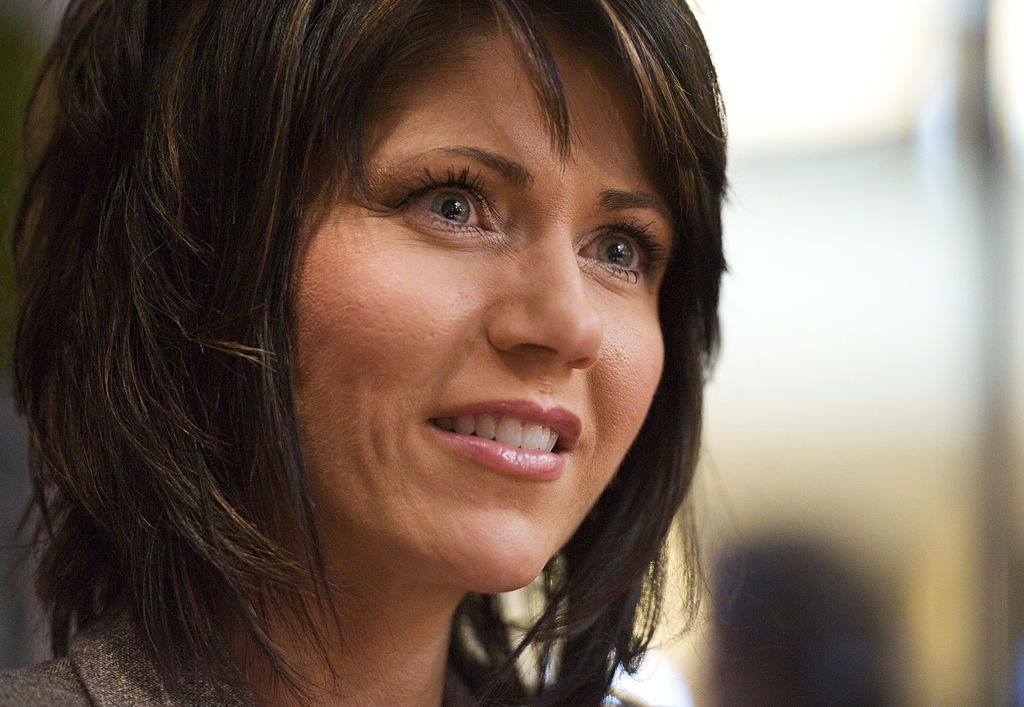
There are certainly some precedents to the MAGA look in conservative politics and media; Fox News hosts of the last couple of decades come to mind. What’s different now?
I mean, it’s Donald Trump. It’s turbo-charged now. This is a man who literally has a background in reality TV. This is a man who doesn’t really know policy, who only cares about how you appear and how you can sell a certain idea. And [Trump’s taste is] extremely garish. Trump is notorious for his love of gold. It can seem so tacky to me, personally, but to him, it signifies wealth and power. When you have the most powerful man in the world having those priorities, people use these visual signifiers to gain power and favor.
Is this really just a rightwing thing? Lots of people, particularly women, feel pressure to conform to a certain look, which increasingly includes cosmetic enhancements.
I’m also a woman in this world, and I absolutely partake in our capitalist beauty standards. Plenty of people on the left, people who are my friends, are also opting to undergo procedures like Botox. You have Gen Z on TikTok being very open about the work they’ve done on their faces. For the longest time, plastic surgery was not accessible to the masses…As it has gotten cheaper and more normalized, people have become more open about it, like how Kris Jenner documented her facelift.
So it’s not completely divided by politics, but I think what’s happening on the right is a bit different. It’s such an appeal to tradition, whereas on the left, there’s more of an embrace, politically and culturally, of gender fluidity. And there’s more of an embrace of sustainability with companies like Reformation and green-friendly makeup, whereas on the right, that’s not at all a concern; it’s all about excess.
Men are secondary to this phenomenon, but they’re certainly in the mix. How do you think the MAGA aesthetic plays out when it comes to masculinity?
Pete Hegseth, to me, is the male equivalent of Kristi Noem. Men like him wear these bright-colored blue suits that don’t just fade into the background, and are supposed to be a sign of patriotism. Their shoulders are extremely broad, whether that is natural or not. Their chins, their jaws are very chiseled. It’s such an aggressive, cartoonish way to represent gender norms, and that absolutely plays into this Donald Trumpian idea of a powerful man. It’s not as ridiculous as the women, maybe because they don’t wear as much makeup. Do these rightwing men want to be known for caring about their looks? Absolutely not. They would see that as a sign of weakness. But there have been reports of Hegseth installing a makeup room in the Pentagon. [“Totally fake story,” Hegseth responded on X.] He puts that same importance on visuals and the message, rather than budgets and policies.
The Evolution of the Rightwing Lewk

Conservative politics has always demanded that women perfectly embody the gender norms of the era.
1970s: Phyllis Schlafly
The “godmother of the conservative movement” intentionally wore ultra-feminine outfits–preppy pastels, skirts in the pantsuit era, and pussy bows–while attacking the Equal Rights Amendment.
Early ‘00s: Gretchen Carlson
Famously crowned Miss America in 1989, she was one of many prominent “Fox blondes.” (In a twist, she was later key to taking down Fox News CEO Roger Ailes for sexual harassment.)
2008: Sarah Palin
Known for her sexy soccer mom look (with a rifle!), she ushered in a departure from the gender-neutral appearance of most female politicians at the time.
2025: Kristi Noem
Tasked with carrying out some of Trump’s cruelest policies, she is the platonic ideal of Mar-a-Lago face: pillowy lips, blinding white teeth, long wavy hair, and lots of makeup.
How Much Is Your Kid Worth?
 July 10, 2025 Greetings, Meteor readers, This weekend my child is attending her first day of soccer camp, and I’m so nervous and excited you’d think we were attending the NWSL draft. But save this email because one day we might be! In today’s newsletter, we cover a sensitive subject: money. Plus, fun news for movie lovers and your weekend reading list. From your newly minted hot soccer mom, Shannon Melero  WHAT'S GOING ONTell your toddler to get a job: We need to talk about taxes. Don’t scroll away from me, this is important! As part of the new tax package passed last week in the “Big Beautiful Bill,” a number of permanent changes have been made to the child tax credit. And for millions of children, those changes are bad. Here’s how it breaks down: For some, the dollar amount will actually increase; if you qualify for the full credit, you get $2,200, up from $2,000. But under the new changes, 2.7 million fewer children qualify than did last year. Unsurprisingly, non-citizens are targeted; to receive the full amount, one parent in the household must have a Social Security number—which was not the case in previous years. The child must have one as well and have lived six months or more in the U.S. with their parent or guardian. (A family headed by an undocumented single parent would not receive the credit at all, even if the child is a citizen.) In failing to write any new protections around eligibility–a dire oversight if you’re actually trying to help more families–the bill inadvertently raised income requirements. A two-parent household with two children has to earn a minimum income of $41,500 to qualify. (This minimum basically didn’t exist in 2024.) If your household earns less than the qualifying income, you may get around $1,700 per child or, in some cases, no money at all. (There is still a maximum, where joint filers making more than $400,000 receive less of the credit.) These numbers change based on other filing factors, but the bottom line is this: Ultimately, about 19 million children are now blocked from receiving the full amount because their family's income is too low. The Center on Poverty and Social Policy at Columbia University found that 60 percent of children of single mothers will not be able to receive the full credit for the 2026 tax season. (That number goes down to 41 percent for children of single fathers. Hm.) When you pair these changes with the cuts to SNAP, early childhood education, and Medicaid, the picture of just how much the government hates low-income families becomes clear. “They don’t give a fuck about us, man” was the first text I received when the BBB passed. Quite a few of my friends and family members are single parents, and while $2,000 once a year didn’t fix all of their problems, it had been a life raft that they looked forward to and depended on. Without it, they’ll be scrambling to cover things like school supplies or daycare payments. I couldn’t even consider having a second child (and just to be clear, Mom, I’m not) because the financial strain would be so great and the safety net so small. Republicans love to tell everyone to have more children, but they’re passing policies that ensure only certain kinds of families will have the financial means to do so. There is, surprisingly, a sliver of hope in all this: state lawmakers. States can still tailor their tax codes to provide more robust child tax credit programs, which already exist in some states. If you don’t know your state’s policy or how to advocate for better, the Coalition on Human Needs has a ton of guides. AND:
 WEEKEND READING 📚On bloodsuckers: Are we headed for a recession? Only Nelini Stamp and the vampires know the answer. (World Builders Club) On pointe: When a ballerina gets pregnant, it often means a huge loss of income. But now dancers are working to change an industry built on their bodies. (Elle) On sportsmen: There are no openly gay or bisexual men competing in America’s professional sports leagues. Why not? (Uncloseted Media)
 FOLLOW THE METEOR Thank you for reading The Meteor! Got this from a friend?
|
![]()


